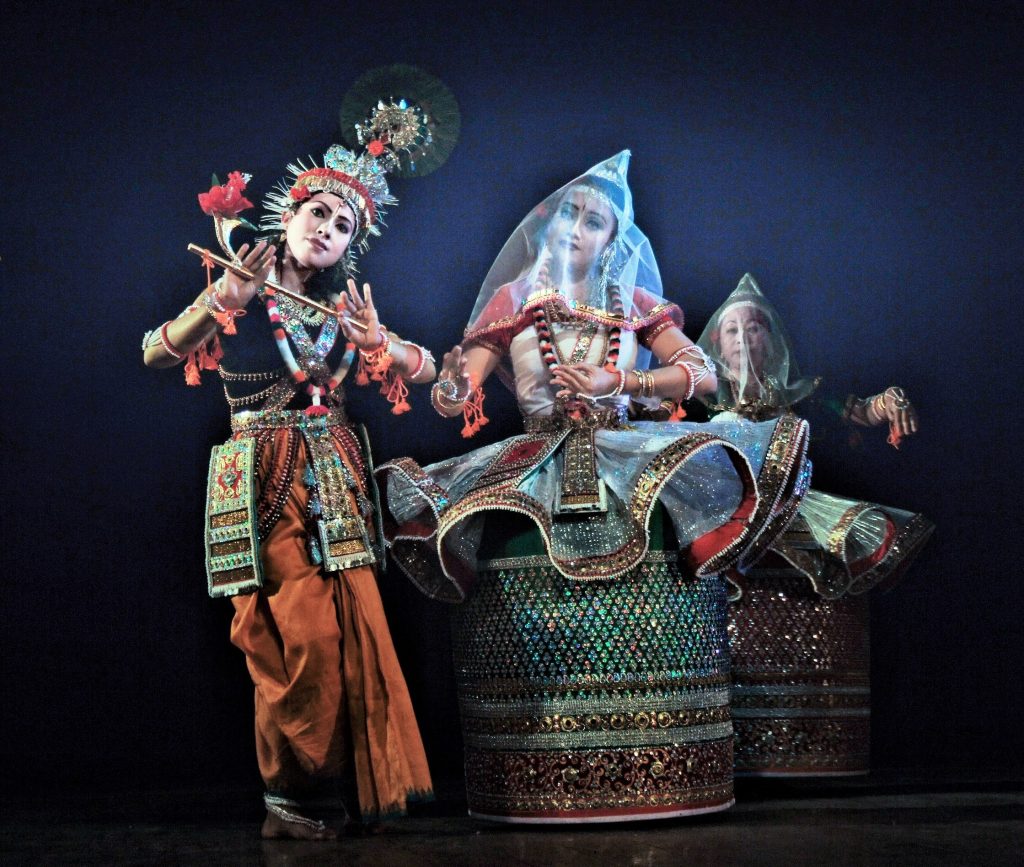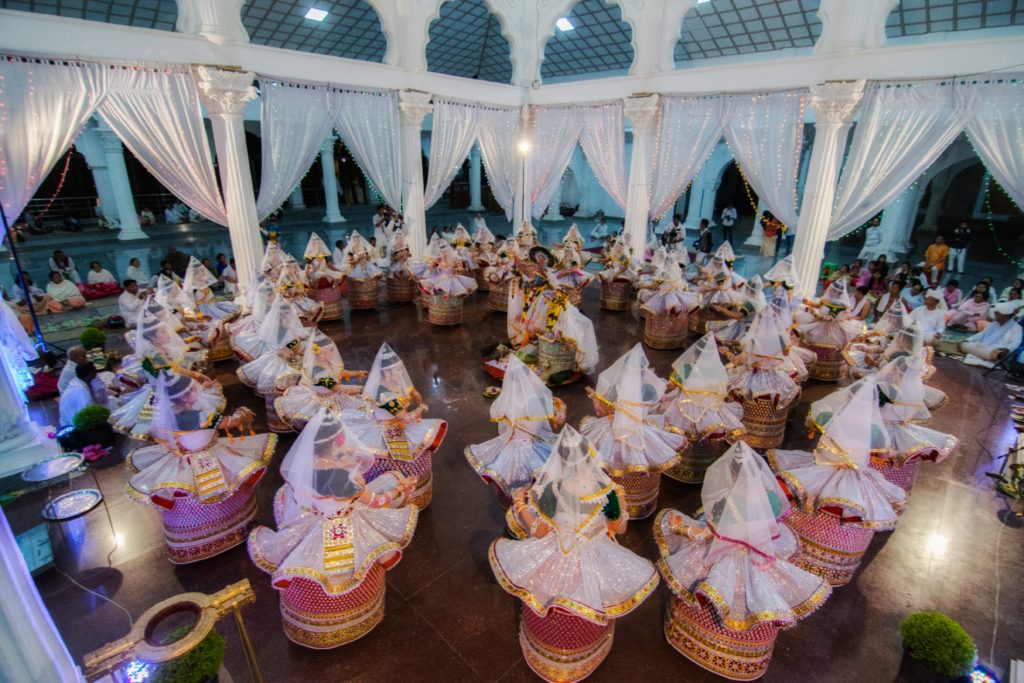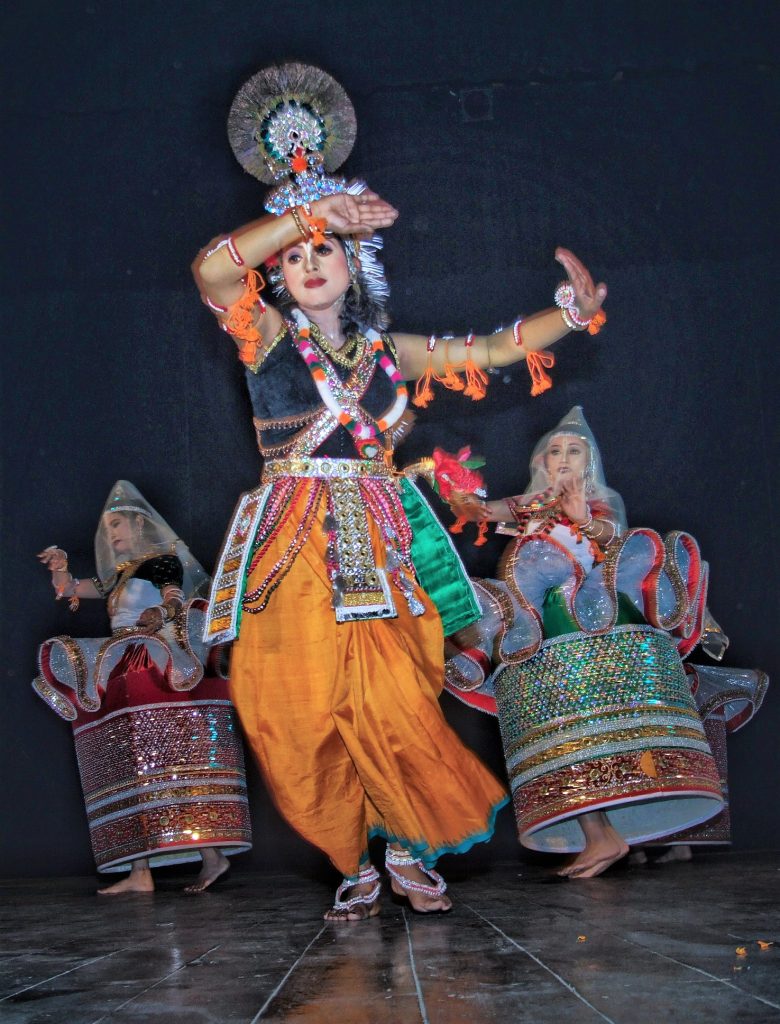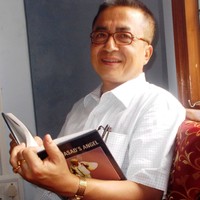Manipur, an erstwhile kingdom, has a chequered history. In the beginning Manipur valley was a vast lake. When the lake started drying up people descended to the valley and settled there. The Meiteis of Manipur are said to be the descendants of a break-away group of the Shang Dynasty of Central China and the Lei-hou tribe of Koubru hill situated in the north-west of Manipur valley. They established their principality in Koubru hill range sometime during the 15th century B.C. Over the centuries, many people belonging to Tai Shan groups from China and Burma (Myanmar) migrated to Manipur and settled in the valley.

King Loyumba (1074-1112 AD) instituted Loyumba Shinyen, a written constitution, which was essential in the reordering of the society to integrate the dominant groups. In many ways principles of this constitution still govern the Meitei social system.
The Ningthouja dynasty of the Meiteis founded by Nongda Lairen Pakhangba in 33 AD ruled Manipur till the British took over in 1891. They installed a royal blood on the throne as a proxy ruler till they left in 1947. The reign of the Ningthouja dynasty continued until the monarchy was abolished in 1949 after the merger of Manipur with India.
Manipur’s connection with Hinduism started when Hindu kingdoms in mainland India were overrun by invaders and people, especially the Brahmins, started running off to safer places to escape the onslaught. Starting from the 15th century A.D. waves after waves of the Brahmins entered Manipur and assimilated into the local population.
Besides the Meiteis, there are 33 recognised tribes in Manipur. Frequent intermarriages with different tribes have also enlarged the gene pool of the Meiteis. More often than not ‘Manipuri’ is used as a generic term to encompass all the peoples living in Manipur.
Doyen of Indian Theatre, Ratan Thiyam maintains, “Manipur is beautiful because of its syncretic culture. We have accommodated every culture, every religion, every ethnicity that came our way, and out of this fashioned a unique identity for ourselves. This is an outlook we inherited from our ancestors and this is precisely what has made our arts great and our society resilient. Why are we questioning this greatness inherent in us now?”
Manipuri culture presents an amazing synthesis of artistic and moral aspects. Manipuri performing arts encompass dance, music, martial arts, drama, etc. To the Manipuris dancing is devotion and submission to God.
The tradition of worshipping pre-Hindu deities continued even after the coming of Hinduism. Meitei religion is centred on the veneration of deities. Lai Haraoba or pleasing of deities, ceremonial rites to appease deities, a pre-Hindu festival, is an important festival of Manipur.
Lai Haraoba has been preserved in its most pristine form — its dance forms and oral literary and poetic traditions are still intact even long after the Meiteis have become Hindus. Hinduism could not totally subvert the pre-Hindu Meitei religion. Even the kings who patronised Hinduism continued to worship pre-Hindu gods and goddesses. Meitei religion reached a modus vivendi with Hinduism.
Rajarshi Bhagyachandra (1759-1760, 1764-1798) is considered to be the most devout of all the Hindu Manipuri kings. During his reign the image of Shri Govindaji at the temple in Imphal was carved out of a jackfruit tree as Shri Krishna had revealed in his dream. He also arranged to cast the image of Sanamahi, a pre-Hindu deity, in metal. He worshipped both the deities.
Classical dance is associated with spirituality and has a deep-rooted relationship with Natya Shastra. Manipuri Ras Lila known as Jagoi Ras in Manipuri is one of the classical dances of India. During his lifetime Rajarshi Bhagyachandra founded three Ras Lilas, viz., (1) Maha Ras, (2) Kunja Ras and (3) Basanta Ras. These original forms of Jagoi Ras belong to temples and are never performed outside the precincts of temples. His successors founded another two Ras Lilas, viz., (1) Nitya Ras and (2) Diva Ras.
Three years after the installation of Shri Govindaji, for the first time Maha Ras in classical tradition was dedicated to Shri Govindaji at Langthabal (Canchipur), on the full moon night of Hiyangei (October-November), in 1779 A.D. It continued for five days in which the chief queen and other members of the royal family took part with the young lady Vimbabati playing the role of Shrimati Radharani. King Bhagyachandra himself played Pung (Mridanga) while his uncle, Ngoubram Shai was the leader of the vocal group.
Jagoi Ras customarily starts with a Sankirtana known as Nat Sankirtana. The term ‘Sankirtana’ signifies a form of song or chanting performed in public to praise God. Dance, song and music all combine with devotion in Sankirtana. In a typical recital, two drummers and many other singer-dancers with cymbals in their hands perform, supplemented by conch blowers. The rituals of Nat Sankirtana are all continuation of the original rituals of Lai Haraoba with suitable changes made to adapt to the need of time, situation and other relevant factors.

“Sankirtana: Ritual singing, drumming and dancing of Manipur” was inscribed on the Representative List of the UNESCO Intangible Cultural Heritage of Humanity during the eighth session of the UNESCO Intergovernmental Committee meeting in Baku, Azerbaijan, held from Monday 2 to Saturday 7 December 2013.
Maharas at Shri Gvindaji temple, Imphal by Kosygin Leishangthem
There are different costumes assigned to the dancers playing Shri Krishna, Shrimati Radhika, Brinda Devi and the Gopis.

Shrimati Radhika, Brinda Devi and Gopis wear potloi, a cylindrical costume made of layers of stiff starched cloths covered with a bright coloured silk cloth (either red or green) on which chamaki or bright metal pieces are sewn. Green coloured potlois are for Shrimati Radhika and Brinda Devi. It is tied to the waist of the female performer. Above it she wears another short skirt like garment called poshwal (poswan). Potloi is so designed that any movement of the legs of the performer is correctly transferred to it. In other words, potloi dances along with the steps of the performer.
All the performers in the three Ras Lilas associated with Govindaji Temple gather up and tie their hair on the top of their heads. Each dancer wears a koktumbi, a conical headwear, over the hair. Then the head is covered with a maikhumbi (semi-transparent white veil).
Khwang-goi, a belt, is tied to the waist. Khwang-nap, a flap, is placed on the front. The upper portion of the body is adorned with resham phurit or velvet blouse. Khaon, astrip of embroidered cloth, is put on across the upper portion of the body from left shoulder to right waist and the flap is dropped below the waist. Khaon is used for the performers in Ras Lilas associated with Govindaji temple.
Shrimati Radhika, Brinda Devi and Gopis in Nitya Ras and Diva Ras can wear either koktumbi or another type of headwear called jhapa. But jhapa is not allowed in Govindaji temple. On their hands they wear khutnam topi (an ornament worn on the top of palm), khuji (bracelet)and khuji thak rattan zoor (an ornament tied to forearm and upper arm).

Shri Krishna wears golden-yellow silk pheijom (dhoti) with green borders. Two Khaons are put on across the upper part of the body from shoulder to waist, from right to left and left to right, with the flaps hanging below the waist on either side. Shri Krishna also wears Khwang-goi and khwang-nap.
Shri Krishna’s headgear comprises of chura, cherei and kajenglei. Chura is the crown of peacock feathers. Cherei or paper-flower is the thin strips of white paper on a string worn at the back of the head. Kajenglei is the circular headdress consisting of numerous brass strips with red tuffs.
On the hand from the top of palm to arm, Shri Krishna wears khutnam topi, khuji popchaobi (thick bracelet), taan (plaque), tanthak (an ornament worn above taan) and tankha (an ornament worn below taan). On the bridge of foot and around the ankle Shri Krishna wears khong-gi leiteng. It covers up sengao sarik or the string of small metal bells around the ankle.
The complete set of costumes for Shri Krishna is called natavaravesh.
- Maha Ras is performed at Govindaji temple at night on the full moon day of Hiyangei, a month according to the traditional Manipuri lunar calendar falling in October-November. It corresponds to Kartika Purnima.
Shri Govindaji representing Lord Krishna participates in Maha Ras. For this purpose, the deity is taken out of the temple in a grand ceremonial procession to the Ras Mandal after rituals. The deity is carefully placed on Vhadra Chakra, a revolving platform at the centre of Ras Mandal. The Gopis dance around while the deity revolves in all directions.
There are some basic differences between Govindaji temple and other temples including Bijoy Govinda. At Govindaji temple, the deity is present at the Ras Mandal. No dancer enacting the role of Krishna is present. At other temples, the role of Krishna is enacted by a dancer. The solo episodes of ‘Radha and Krishna’ or ‘Krishna Nartan’ are there. At Govindaji temple, instead of the episodes of ‘Radha and Krishna’ a significantly big Artika is offered in the beginning with the two deities of Shrimati Radharani and Shri Krishna installed on the Vhadra Chakra.
Historically, Maha Ras was performed in the precincts of Govindaji temple with the participation of the members of the Royal family. As it is more ritualistic and have certain practices to be followed, very little change has taken place in this form.
- Kunja Ras is performed at Govindaji temple at night on the full moon day of Mera, a month according to the traditional Manipuri lunar calendar falling in September-October.
In Kunja Ras Shri Krishna meets the Gopis at a secret grove of their choice.
- Basanta Ras is performed at Govindaji temple at night on the full moon day of Sajibu, a month according to the traditional Manipuri lunar calendar falling in March-April. The season of colours is enacted in the Ras. Chandravali, the second in devotional ecstasy to Shrimati Radharani too joins Basanta Ras. The episode of Mana signifying the discarding of Shri Krishna by Shrimati Radharani is the most thrilling and sympathetic portion of Basanta Ras.
- Nitya Ras was founded by Maharaja Chandrakirti (1850-1886).
This Ras Lila is not dedicated to Shri Govindaji. One of king’s daughters, princess Sanatombi married and lived with her British husband major Maxwell, the then British administrative officer. This relationship was not approved by the Royal family. According to Manipuri custom at the time she was regarded as an outcaste. Princess Sanatombi organized the Nitya Ras founded by her father and celebrated it outside the temple premises with herself in the role of Makokchingbi (a major in the Ras Lila).
Nitya Ras can be performed in any month of the year except Sajibu, a month according to the traditional Manipuri lunar calendar falling in March-April. Female dancers of Nitya Ras were not allowed to use Koktumbi or the headdress of Shrimati Radha and Gopis for the three dance forms associated with Govindaji temple. Nitya Ras is also known as Nartana Ras.
- Diva Ras was created during the reign of Maharaja Churachand (1891-1941).
Diva Ras is the youngest of the five Ras Lilas. It started during the reign of Sir Churachand Singh, the royal head during the British Manipur administration. The time was around 1940 A.D. before World War II.
This Ras Lila is performed during day time hence called Diva Ras. The time of Diva Ras is scheduled ahead of the time of Shri Krishna’s coming back home along with the cows from the pasture.
Manipuri Ras Lilas have undergone many transformations since Rajarshi Bhagyachandra created Maha Ras. In the olden days traditional dancers, singers and artists could survive because of the patronage of kings and dignitaries. Now, they are left to fend for themselves to stay alive. To earn their livelihood they have to bend their ways and try to adapt to the present trend. To attract tourists and entertain people Manipuri Ras Lilas have come out of temples. Excerpts have also been adapted for stage performance. Performance lasting whole night has been squeezed into ten to fifteen minutes![]()
References: –
Tayenjam Bijoykumar Singh, ‘Beyond the Spectrum: The Tradition of Lai Haraoba’ / Northeast India: The Insiders’ Definition. Marg, Volume 63 Number 4, June 2012
R.K. Danisana, Manipuri Dances (A Panorama of Indian Culture). Rajesh Publications, New Delhi 2012
Haobam Ibochaoba Singh, The Pre-World War-II Form of Ras Leela. Published by (L) Haobam Ongbi Shantibala Devi W/o H. Ibochaoba Singh, Uripok Haobam Dewan Leikai, Imphal, January, 2009
K.C. Tensuba, Genesis of Indian Tribes: An approach to the History of Meities and Thais (first published in India by M.C. Mittal, Inter-India Publications, New Delhi in 1993)
M. Kirti Singh, Religion and Culture of Manipur. Manas Publications, Delhi, 1988
E. Nilakanta Singh, Fragments of Manipuri Culture. Omsons Publications, New Delhi, 1993
Pradip Phanjoubam, “Drama in the time of bigotry: theatre director and poet Ratan Thiyam” in the Hindu, December 01, 2018 04:15 pm | Updated December 02, 2018 10:21 am IST; https://www.thehindu.com/entertainment/theatre/drama-in-the-time-of-bigotry/article25641764.ece. Accessed on December 4, 2022
Saroj Nalini Parratt, “The Court Chronicle of the Kings of Manipur; the Cheitharon Kumpaba”. Routledge, Oxon, simultaneously published in the USA and Canada, First published 2005. (CK Vol. 1)
Saroj Nalini Parratt, “The Court Chronicle of the Kings of Manipur; the Cheitharon Kumpaba”. Vol. 2. 1764—1843 CE, Cambridge University Press India Pvt. Ltd., First published 2009 (CK Vol. 2)

Tayenjam Bijoykumar Singh is a bilingual poet, writer and translator from Imphal, India. He writes poetry, short-stories and nonfiction in both English and Manipuri. His original writings and translations in English have appeared in Oxford University Press Volumes, Sabd, Pratibha India, Interstate Commerce Commission Quarterly, Chandrabhaga, Imphal Free Press, North-East Frontier, Sentinel / Melange, Katha Volumes, Glimpses from the North-East (published by National Knowledge Commission), Marg etc.He is the Vice–president of, North East Writers” Forum, a life member, of Naharol Sahitya Premee Samiti, Imphal, and an advisor, Chorus Repertory Theatre, Imphal founded by Ratan Thiyam.
